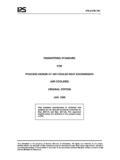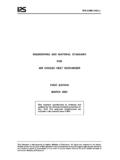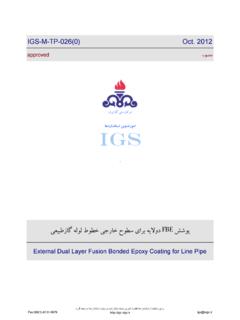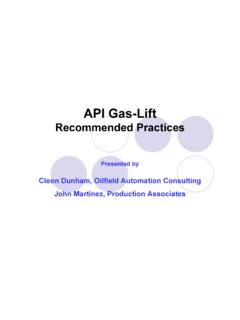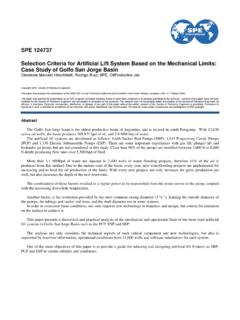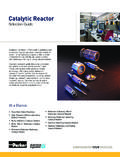Transcription of Gas Lift Design and Technology - N.I.G.C
1 SchlumbergerGas Lift Design and TechnologySchlumbergerSchlumbergerSchlum bergerSchlumbergerWell Completions and ProductivityWell Completions and ProductivityWell Completions and ProductivityWell Completions and ProductivityChevron Main Pass 313 Optimization ProjectChevron Main Pass 313 Optimization ProjectChevron Main Pass 313 Optimization ProjectChevron Main Pass 313 Optimization Project09/12/001-1 gas lift Design And Technology Schlumberger1999 gas lift Design AND TECHNOLOGY1. Introduction & Basic Principles of Gas Lift1-2 gas lift Design And Technology Schlumberger19991. Introduction & Basic Principles of Gas LiftCHAPTER OBJECTIVE: To give an overview of gas lift principles and their applicationswith illustrations of continuous and intermittent gas lift wells completed in oil producing sands will flow naturally for some period of time after they beginproducing. Reservoir pressure and formation gas provide enough energy to bring fluid to the surface in aflowing well. As the well produces this energy is consumed, and at some point there is no longer enoughenergy available to bring the fluid to the surface and the well will cease to flow.
2 When the reservoirenergy is too low for the well to flow, or the production rate desired is greater than the reservoir energycan deliver, it becomes necessary to put the well on some form of artificial lift to provide the energy tobring the fluid to the surface. The types of artificial lift available are illustrated in Figure 1-1. When gaslift is used, high-pressure gas provides the energy to enable the well to 1-1: Artificial Lift Systems1-3 gas lift Design And Technology Schlumberger1999 When a well is completed, a series of conductor pipes and accessories are installed during wellcompletion operations. The basic components of the system are labeled in Figure This is a simplifiedillustration of a cased hole single zone completion. Dual and triple completions are much more complexand will not be considered here. The inner surface of the well bore is supported by the casing may be up to three separate casing strings including a surface and intermediate string.
3 The spacebetween the tubing and casing is called the annulus. The packer seals the annulus just above theproducing zone. The casing has been perforated adjacent to the producing zone to allow entrance of gasand liquid products into the wellbore or the tubing string may extend into the open hole. When reservoirdrive does not provide enough pressure to lift fluids to the surface, additional equipment must beinstalled to help lift the fluids. There are four basic types of artificial lift: sucker rod pumping, hydraulicpumping, centrifugal pumping and gas 1-2 Completed WellTable compares these systems and lists the advantages and disadvantages of each. As you can seethere are two basic types of gas lift used in the oil industry. They are called continuous flow gas lift andintermittent gas lift . The two types operate on different principles and it is always advisable to treat themas two separate Lift Design And Technology Schlumberger1999 Table Types of Artificial Lift SystemsContinuousAdvantagesGAS LIFTING1.
4 Takes full advantage of the gas energyavailable in the Is a high volume Equipment can be Can handle sand or trash Valves may be wireline or Cannot pump off and minimum bottomhole producing pressure in creases bothwith depth and Must have a source of Can obtain lower producing pressure thancontinuous gas lift obtains and at Equipment can be Valves may be wireline or Pumping:1. Is possible to pump Is best understood by field Some pumps can handle sand or Where suitable, it is usually the cheapestlift Pumping:1. High volume can be produced from It is possible to almost pump Equipment can be Pumps can be changed without Pumping:1. Very high volumes at shallow depth canbe Is possible to almost pump Is limited in maximum Cannot pump Causes surges on surface Must have a source of Maximum volume drops off fast Is very susceptible to free gas in Equipment gets scattered over Pulling rods are required to change Is very susceptible to free gas in pumpcausing Is vulnerable to solid matter in Oil treating problems are greatlyincreased because of power oil in Well testing can be difficult due to poweroil including in well Maximum volume drops off fast Is very susceptible to free gas in pumpcausing Control equipment is required on Tubing must be pulled to change pumpand Lift Design And Technology Schlumberger1999 Advantages and Limitations of Gas LiftThe flexibility of gas lift in terms of production rates and required depth of lift cannot be matched byother methods of artificial lift for most wells if adequate injection gas pressure and
5 Volume are lift is considered one of the most forgiving forms of artificial lift since a poorly designed installationwill normally gas lift some fluid. Many efficient gas lift installations with wireline retrievable gas liftvalve mandrels are designed with minimal well information for locating the mandrel depths upon initialwell completion in offshore and inaccessible onshore deviated wells that produce sand and have a high formation/liquid ratio are excellent candidatesfor gas lift when artificial lift is needed. Many gas lift installations are designed to increase the dailyproduction from flowing wells. No other method is as ideally suited for through-flow-line (TFL) oceanfloor completions as a gas lift system. Maximum production is possible by gas lift from a well withsmall casing and with high deliverability and bottomhole retrievable gas lift valves can be replaced without killing a well with a load fluid or pulling thetubing.
6 Most gas lift valves are simple devices with few moving parts. Sand laden well production fluidsdo not pass through the operating gas lift valve. The subsurface gas lift equipment is relativelyinexpensive. The surface injection gas control equipment is simple and light in weight. This surfaceequipment requires little maintenance and practically no space for installation. The reported overallreliability, replacement and operating costs for subsurface gas lift equipment are lower than for othermethods of most important limitation of gas lift operation is the lack of formation gas or the availability of anoutside source of gas. Other limitations include wide well spacing and unavailable space forcompressors on offshore platforms. gas lift is seldom applicable to single well installation and to widelyspaced wells that are not suited for a centrally located power system. gas lift is not recommended forlifting viscous crude, a super-saturated brine or an emulsion.
7 Old casing, dangerously sour gas and longsmall ID flowlines can eliminate gas lift operations. Wet gas without proper dehydration will reduce thereliability of gas lift systems of artificial lift requires obtaining considerable information about well some measurements are taken, some of the required data must be estimated by making certaininferences from available data. A system of nomenclature has been adapted by petroleum experts todesignate certain well Lift Design And Technology Schlumberger1999It is important to know the pressure at various points in the system. Pressure is expressed in pounds persquare inch (psi) or [Kilopascals (kPa)]. For gas lift calculations, pressure is understood as gaugepressure (psig).Figure illustrates some points in a well where pressure readings are taken. Pressure at the bottom ofthe hole (Pbh) caused by the drive mechanism within the reservoir can be expressed as a static pressure(Pbhs) or if the well is flowing as a flowing bottom hole pressure (Pbhf).
8 If a flowing well is shut in, thebottom hole pressure is expressed as Pws. It is necessary to use pressure data along the tubing string (Pt)and within the tubing casing annulus (Pc). The tubing pressure at the wellhead is referred to as is measured along the tubing string from the wellhead (Twh) to bottom hole (Tbh) as can beseen in Figure Temperature is usually expressed in degrees Fahrenheit or degrees Celsius. Figure Figure Well MeasurementsWell Temperature MeasurementsFor intermittent gas lift installations, the calculation of volume of the tubing and casing for a given lengthis required for gas lift Design . When the annular volume and tubing volume are known, a ratio of thesevolumes can be calculated (Fct). The static fluid level (SFL) refers to the level of liquid before artificiallift occurs and the working fluid level (WFL) is the level of the fluid during any given time duringartificial lift (See Figure ).
9 Wells that are in production vary a great deal (See Figure ). Aconsiderable amount of information about the quality and quantity of the fluids produced is necessary forgas lift Design . The specific gravity ( ) or relative density of the liquid can be determined. Themixture can be analyzed by comparing the amount of Gas (qg) to Liquid (ql) deriving the Gas to LiquidRatio (GLR), the amount of Gas to Oil (GOR) and the amount of water (qw) to amount of oil to (qo)deriving WOR Lift Design And Technology Schlumberger1999 Figure Figure Well Fluids A Producing WellQuantities of gas (Q) are expressed in scf or standard cubic feet, defined as a cubic foot of a gas understandard conditions ( psia and 60 ), or [M3] [M3 standards are 20 C and kPa]. Thechange in any variable, from one point to another, is referred to as a gradient (G). A number of gradients(pressure and temperature) are observed as one travels up and down the tubing a gas lift system to work correctly, the following basic concepts and components must be The well is capable of production but lacks reservoir energy to raise the produced fluids to the fluids will rise to some point called the static fluid level and must be lifted from that point to thesurface by artificial The gas pressure must be adequate for injection into the well.
10 Either it has sufficient pressure to makethe gas lift system operate, or it must be compressed to raise the pressure. The volumes of gas to be usedand the pressures available to the well will have been taken into account in designing the gas liftinstallation. The gas line bringing the input gas to the well will be of adequate size and pressure rating tohandle the gas supply. Before connecting the gas line to the control equipment, it is essential that the linebe flushed for a period of time to eject all foreign matter such as dirt, trash, etc. from the line. Much ofthe control equipment is susceptible to being plugged with such foreign matter, giving rise to operatingproblems in the gas lift valves are placed in mandrels, which are run in the tubing string and are automatic inoperation, opening and closing in response to preset pressures. Conventional mandrels are run on thetubing with the valve mounted on the exterior part of the mandrel before the string is run.
